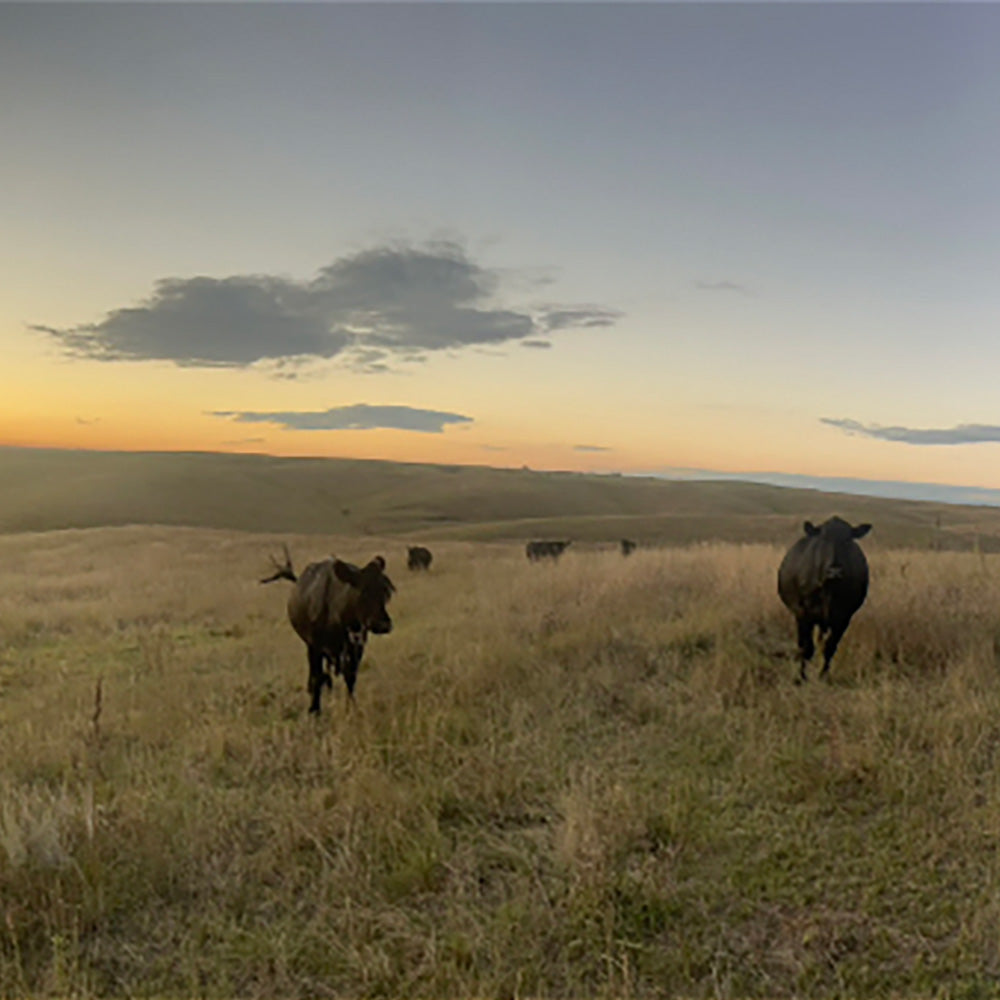
Grass-fed beef vs grain-fed is one of the most debated topics in today’s meat industry. At KL Beef Co., we don’t approach this as a marketing angle—we approach it as ranchers. For six generations, we’ve raised beef in Nebraska with a focus on health, heritage, and honesty. So when people ask us about grass-fed beef vs grain-fed, we take the time to explain it the way we live it.
Where It Starts: The Same Pasture
At KL Beef Co., all of our cattle start the same way: born on our ranch, raised on rotated Nebraska pasture, and cared for daily by our family. That means they begin life grass-fed, just like cattle have for centuries. Grass remains the foundation of their diet and well-being throughout their time here.
For us, this isn’t about meeting a label. It’s about doing what’s right for the land and for the animal. But to understand the full picture of grass-fed beef vs grain-fed, it’s important to look at what happens next.
Understanding the Finish: What Grass-Fed vs Grain-Fed Really Means
The difference between grass-fed beef vs grain-fed comes down to how cattle are finished—the last 3 to 6 months before harvest. In strictly grass-fed systems, cattle eat forage (pasture, hay) for life. In grain-finished systems, cattle start on grass and transition to a ration of grains and roughage.
At KL Beef Co., we finish with a mix of alfalfa, oats, and grains grown in our region. This provides both energy and consistency, allowing us to dry-age beef that’s well-marbled and flavorful.
Why We Finish with Grain
It’s a question we get often—why finish with grain if grass is natural? The answer lies in balance. Grain finishing, when done carefully and in moderation, offers several benefits without compromising animal welfare or nutritional quality.
- Flavor and Tenderness: Grain finish enhances marbling, which is key to flavor and tenderness—especially important when dry-aging our premium beef.
- Consistency: Our customers expect a consistent experience when they order beef online. Grass alone can vary by season and rainfall, but a grain finish helps stabilize quality.
- Digestive Health: Our grain-finishing ration is designed with forage and digestibility in mind. It’s not the industrial feedlot model—it’s a finishing step grounded in care.
So when comparing grass-fed beef vs grain-fed at KL Beef Co., it’s not a factory vs farm scenario. It’s grass-based, hands-on stewardship from start to finish.
Debunking the Myths
There’s a lot of confusion when it comes to grass-fed beef vs grain-fed, often driven by marketing or incomplete information. Let’s clear up a few common myths.
Myth 1: Grain-Fed Beef Is Less Healthy
Reality: Beef nutrition depends on more than the last few months of feeding. Our Nebraska beef is rich in essential nutrients regardless of finishing—iron, B vitamins, protein, and omega-3s all remain. While grass-only beef may have slightly more omega-3s, the difference is modest when beef is part of a balanced diet.
Myth 2: Grass-Fed Beef Is Always More Humane
Reality: Humane treatment depends on ranch practices—not just feed. At KL Beef Co., whether cattle eat hay or grain, they’re raised with daily hands-on care, rotated pastures, and no confinement. That’s what matters most.
Myth 3: Grain Means Feedlots
Reality: Not here. Our grain-finished cattle never leave our ranch. No auctions, no feedlots. Just the same family raising the same herd—start to finish.
A Nebraska Rancher’s View
The grass-fed beef vs grain-fed debate can sound loud online. But in Nebraska, where cattle outnumber people, we see things more clearly. We’re not chasing trends—we’re preserving tradition while being transparent.
Morgan Rhea explains it this way:
"Our cattle are raised on grass, finished with care, and harvested with purpose. We’re not feeding labels—we’re feeding families."
That’s the KL Beef Co. difference. It’s not about grass-fed beef vs grain-fed—it’s about beef done right.
Dry-Aged Beef: The Final Step
No matter how cattle are raised, the final touch is what makes KL Beef Co. different. Every cut of our angus beef is dry-aged for at least 14 days. This process intensifies flavor and tenderness in a way that no feeding system alone can replicate.
When our customers ask about grass-fed beef vs grain-fed, we always point to what ends up on the plate: clean, flavorful, hand-selected Nebraska beef.
Supporting Nebraska Beef with Transparency
At KL Beef Co., we offer more than premium beef. We offer confidence.
- We raise what we sell.
- We dry-age every cut.
- We finish with integrity.
- We tell you exactly how it’s done.
For customers searching for premium beef, dry-aged beef, or Nebraska beef online, this level of honesty sets us apart.
What to Know Before You Choose
If you’re weighing the choice between grass-fed beef vs grain-fed, ask yourself these questions:
- Do I know how the animal was raised?
- Is the beef dry-aged or wet-aged?
- Is this purchase supporting a rancher or a processor?
- Does the source align with my values?
We’re not here to say grass-only or grain-only is best. We’re here to say: know your rancher. Ask questions. Understand the process. And when you're ready, try the difference for yourself.
Experience the KL Beef Co. Standard
Explore our dry-aged Nebraska beef—raised on pasture, finished with balance, and delivered with purpose. Our grass-fed beef vs grain-fed approach is about more than feed—it’s about care.
- Shop our steak boxes, quarter cows, and family bundles
- Learn more about our sixth-generation Nebraska ranch
- Taste beef raised with integrity and tradition
KL Beef Co.: Nebraska Beef, Raised Right.
